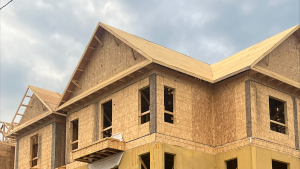Few building material industries have undergone such transformation in recent years than that of concrete. Grabbing most of the headlines are the increasing ways carbon can be reduced, captured or utilized at various stages of concrete’s manufacture.
Certainly low carbon concrete is important going forward. Meanwhile at the research level, more is going on that may impact how concrete is formed, used and later treated after its original life.
Researchers at MIT have developed a method to use lightly treated mud, including soil from a building site, to create “formwork” molds into which concrete is poured. These 3D printed mud molds can replace the elaborate wood formworks currently used in concrete construction and at a much reduced cost.
The MIT development team says when combined with additives such as straw and a wax-like coating to prevent water from draining out of the concrete, the soil material becomes firm enough to handle poured concrete. Any number of custom formwork shapes can be created. Not only would this molding method reduce costs but it would also reduce carbons and be infinitely recyclable after use.
“What we’ve demonstrated is that we can essentially take the ground we’re standing on, or waste soil from a construction site, and transform it into accurate, highly complex and flexible formwork for customized concrete structures,” says Sandy Curth, a PhD student in MIT’s department of architecture who helped spearhead the project.
Another challenge being addressed through ongoing research is the brittle nature of concrete.
“Concrete by itself does not show any tensile properties, meaning if you have a piece of concrete and start pulling it apart, it can easily break. It’s a very brittle material,” says Maryam Hojati, of the Gerald May Department of Civil, Construction and Environmental Engineering at the University of New Mexico. “Concrete is a great material for compression, but when it comes to tension, it’s a weak material.”
Hojati and two associates have patented a self-reinforced ultra-ductile cementitious material. It is aimed particularly at 3D concrete printing, allowing it to move away from the currently required reinforcing beams and rebar.
The challenge was to develop a cementitious material containing enough fiber to stand firmly on its own while maintaining a viscosity allowing it to pass through the printing nozzle without getting stuck, the university’s release explains. The end result was a mixture that could hold all of the concrete together when subjected to any bending or tension load, Hojati says.
In other words, Hojati’s team has developed a bendable printable concrete-like substance.
“If we use this material at a larger scale, we can minimize the requirement of external reinforcement to the printed concrete structure.”
Another development has been brought forward by Chinese scientists called Light-Transmitting Concrete (LTC) that could expand the ornamental use of concrete in buildings.
“LTC is a combination of internal light-conducting elements embedded in a cement matrix; the light source can be outdoor light or indoor light, and the light-conducting elements can consist of other materials, such as glass, transparent resin, optical fibers, etc.,” the researchers write. “LTC can be applied to building facades to reduce building energy consumption; pavement to increase visibility and safety; and outdoor decorations in parks to add to their esthetic appeal.”
Understanding LTC’s potential is at an early yet promising stage, awaiting data on mechanical, light transmission and durability properties, not to mention cost factors.
And finally, although concrete’s afterlife has been seen as limited, unlike reusable building components such as steel, aluminium and wood, it may not necessarily be the end of road for concrete.
Australia’s Flinders University and the University of Melbourne write experts are developing a “value add” for old broken concrete by upcycling coarse aggregate using a weak graphene solution to produce concrete that is potentially superior to untreated recycled road aggregates in cement-based mixtures.
John Bleasby is a freelance writer. Send comments and Inside Innovation column ideas to editor@dailycommercialnews.com.











Recent Comments